The three countries that helped Moscow to maintain crude exports in the wake of its invasion of Ukraine appear to be stepping back into the market for Russian barrels, with Turkey taking a lead role in the latest buying.
A marked increase in the volume of crude on tankers that have yet to signal a final destination makes the task of monitoring Russia’s exports more complicated, but most of those vessels end up in India, with a smaller number heading further east to China. Adding those ships into the calculation shows a steady increase in the combined flow of Russian crude to Turkey, China and India in recent weeks.
Almost all tankers carrying Russian crude that signal destinations such as Port Said, Gibraltar or “for orders” eventually end up in one of those three countries.
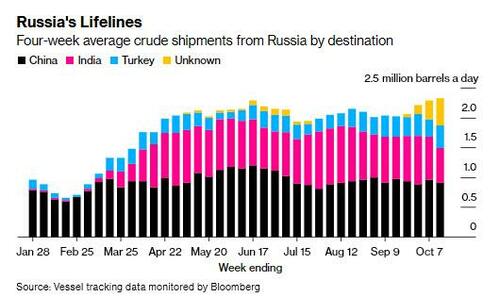
Time is running out to deliver crude from Russia’s Baltic ports to China and India before European Union sanctions that will deprive vessels of insurance and other services come into effect on Dec. 5. Tankers have until about Oct. 21 to depart Primorsk or Ust-Luga if they are to reach discharge terminals in eastern China before that deadline.
Flows to China, India and Turkey peaked in June at 2.2 million barrels a day. In the four weeks to Oct. 14 that figure was down by about 350,000 barrels a day. However, shipments to Turkey have risen to the highest level for the year so far, while the volume on tankers yet to show final destinations is now so large, at the equivalent of more than 450,000 barrels a day, that it could send combined shipments to these three countries to new post-invasion highs once their actual destinations become apparent.
Meanwhile, trading houses and refiners are racing to book storage tanks in Rotterdam in the coming months on expectations of a supply crunch after the EU sanctions take effect.
Crude Flows by Destination:
Overall exports rose on a four-week average basis, climbing to the highest since mid-August and exceeding 3 million barrels a day for the first time in five weeks. The increase was driven by flows to Europe, which were higher to all three regions of the continent.

All figures exclude cargoes identified as Kazakhstan’s KEBCO grade. These are shipments made by KazTransoil JSC that transit Russia for export through Ust-Luga and Novorossiysk.
The Kazakh barrels are blended with crude of Russian origin to create a uniform export grade. Since the invasion of Ukraine by Russia, Kazakhstan has rebranded its cargoes to distinguish them from those shipped by Russian companies. Transit crude is specifically exempted from EU sanctions on Russia’s seaborne shipments that are due to come into effect in December.
Crude Flows by Destination:
Europe
Russia’s seaborne crude exports to European countries rose for the first time since the beginning of September, increasing to 714,000 barrels a day in the four weeks to Oct. 14. Flows were up by 89,000 barrels a day, or 14%, from the period to Oct. 7. These figures do not include shipments to Turkey.

The volume shipped from Russia to northern European countries rose in the four weeks to Oct. 14, making back the previous week’s loss. All shipments went to storage tanks in Rotterdam.
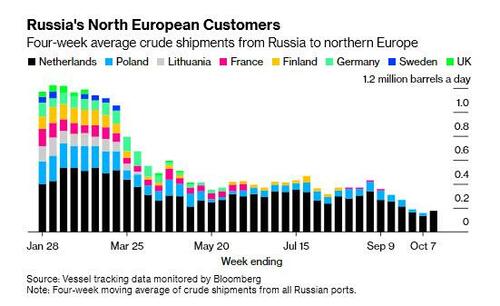
Exports to Mediterranean countries jumped in the four weeks to Oct. 7. Flows to the region, including Turkey, which is excluded from the European figures at the top of this section, rose to a five-week high — with the volume heading to Turkey at its highest for the year so far.
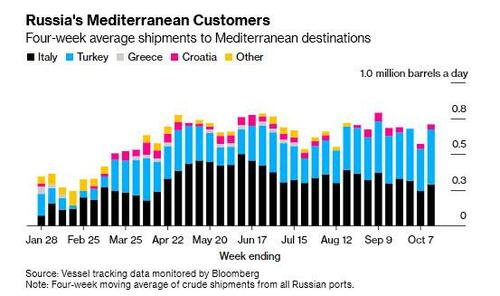
Combined flows to Bulgaria and Romania rose above 200,000 barrels a day for the first time in seven weeks, with almost all of that volume heading to Bulgaria.
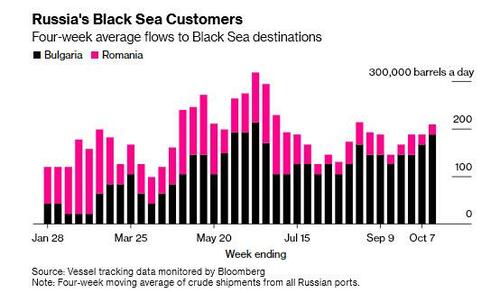
Asia
Shipments to Russia’s Asian customers slipped. The four-week average volume of crude heading from Russia to Asia, plus those on vessels showing no final destination, which typically end up in either India or China, edged lower from a 16-week high. Shipments heading to Asia averaged 1.83 million barrels a day over the four weeks to Oct. 14, with a further 160,000 barrels a day on tankers whose point of discharge is unclear.
All of the tankers carrying crude to unidentified Asian destinations are signaling Port Said or the Suez Canal, with final discharge points unlikely to be apparent until they have passed through the waterway into the Red Sea, at the earliest. Most of those ships end up in India or China, with the occasional vessel heading to other destinations such as Fujairah in the United Arab Emirates, or Colombo in Sri Lanka.

Flows by Export Location
Aggregate flows of Russian crude increased by 200,000 barrels a day, or 7%, in the seven days to Oct. 14, compared with the previous week. Flows were unchanged from all regions except the Pacific. Figures exclude volumes from Ust-Luga and Novorossiysk identified as Kazakhstan’s KEBCO grade.
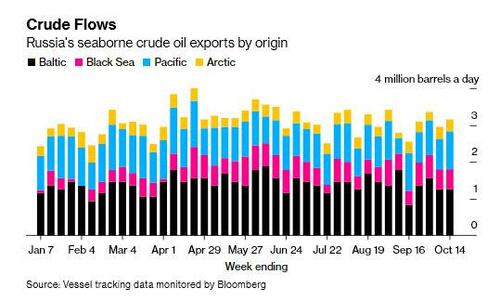
Export Revenue
Inflows to the Kremlin's war chest from its crude-export duty increased, rising by $9 million to $134 million in the seven days to Oct. 14. The four-week average income also edged higher, gaining $2 million to $145 million.

At $6.06 a barrel, the export duty rate in October is the lowest per barrel rate since February 2021, according to Bloomberg calculations using figures published by the Russian Ministry of Finance.
Duty rates will fall again in November, dropping to $5.83 a barrel, taking them to their lowest level since January 2021. The Urals discount to Brent widened during the latest calculation period, which ran from Sept. 15 to Oct. 14, compared with the previous one, to stand at about $25.50 a barrel.
Origin-to-Location Flows
The following charts show the number of ships leaving each export terminal and the destinations of crude cargoes from the four export regions.
A total of 30 tankers loaded 22 million barrels of Russian crude in the week to Oct. 14, vessel-tracking data and port agent reports show. That’s up by 1.4 million barrels. Destinations are based on where vessels signal they are heading at the time of writing, and some will almost certainly change as voyages progress. All figures exclude cargoes identified as Kazakhstan’s KEBCO grade.

The total volume on ships loading Russian crude from Baltic terminals was unchanged at 1.25 million barrels a day. Shipments to Europe from Primorsk and Ust-Luga rose to the highest in six weeks.
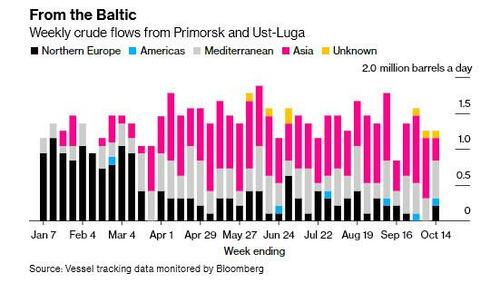
Shipments from Novorossiysk in the Black Sea were also unchanged from the previous week.
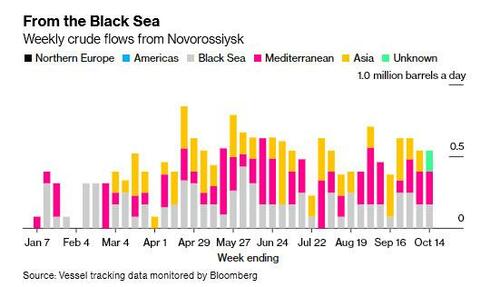
Arctic shipments, too, were unchanged, with three vessels departing Murmansk in the week to Oct. 14.
The Pacific was the only region to show higher shipments in the week to Oct. 14, with flows reaching a four-week high of 1.04 million barrels a day. Nine cargoes of ESPO crude were loaded, with all but one heading to China. The other ship is heading to India. A cargo of Sakhalin Blend crude is also heading to China.
By Julian Lee via Zerohedge.com
More Top Reads From Oilprice.com:



















Moreover, EU banned seaborne Russian crude imports after 25 December 2022 won’t be lost to Russia. They will either be shifted towards the Asia-Pacific region or will return to the EU and the world in the form of both Chinese and Indian petroleum products refined from bought Russian crude.
Dr Mamdouh G Salameh
International Oil Economist
Global Energy Expert